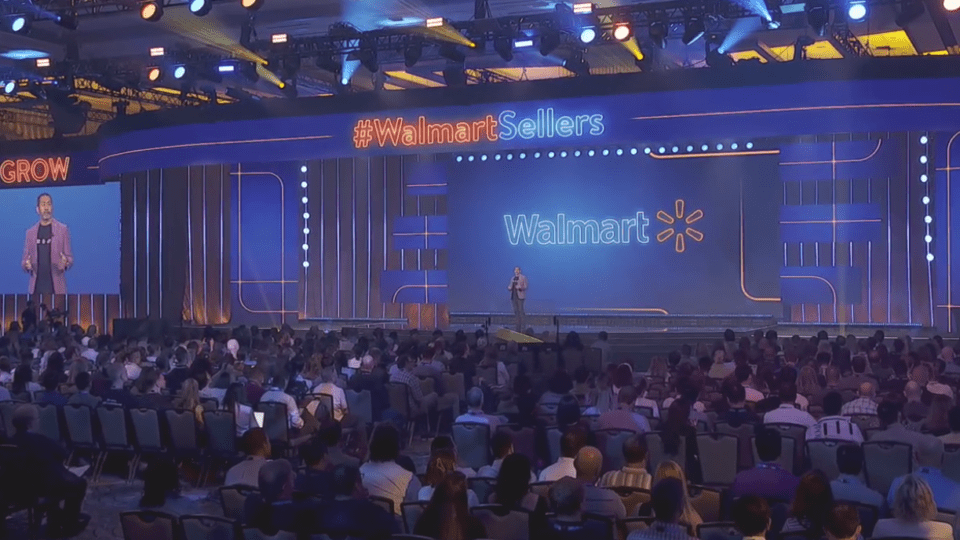Exhibit A — how Amazon built its hugely successful digital commerce business: 1. Create an effective ecommerce platform 2. Open that platform to third-party sellers 3. Sell those sellers access to logistics and fulfillment services, many of which were already built for its own first-party retail business 4. Sell those sellers advertising opportunities so they have a better chance of standing out amid the ever-growing crowd of other sellers.
Exhibit B — how Walmart is building its digital commerce business: See Exhibit A.
Yes, this is a vastly simplified summary of decades of digital and logistical innovation, but it’s also true — Walmart is unabashedly following Amazon’s ecommerce playbook, right down to hosting a fanfare-filled event for its marketplace sellers.
Walmart held its first-ever seller summit, called “Let’s Grow,” on Aug. 30. (Amazon will hold its fourth annual “Accelerate” summit Sept. 13 and 14.) As at past Amazon Accelerate events, Walmart’s first official seller summit was chock-full of feel-good seller anecdotes, stirring speeches about partnership and innovation and the unveiling of new capabilities.
“This is our first-ever seller summit, but it’s been a really long time coming,” said Tom Ward, EVP and Chief Ecommerce Officer for Walmart U.S., speaking to the more than 1,000 sellers present at the event. “Our sellers are a huge part of our customer value proposition, because it’s not just what we buy, but it’s what we sell that matters to our customers, and that’s where you guys come in. Our customers are changing rapidly. They want more items, more often, in more ways and faster than ever before. And as their demands change, we’re constantly changing too. It’s sessions like this one that help underline that change and put us in the best position to meet their demands by providing them with the items and experience they want, expect and deserve.”
Many of the biggest announcements at Walmart Let’s Grow were functionalities that (you guessed it) Amazon has previously rolled out, such as branded store pages for marketplace sellers (which Amazon launched in 2018) and local pickup and delivery of Walmart.com orders from sellers’ own physical stores (which Amazon rolled out in 2021).
Walmart might seem to be simply a Johnny-come-lately or a copycat except for its biggest differentiator, and it’s one that might just prove to be a decisive advantage — its 4,600 brick-and-mortar stores.
“Amazon leaders worried for decades that Walmart would someday utilize its massive store network as an advantage in ecommerce to quickly fulfill both pickup and delivery orders,” said Jason Del Rey, author of the book Winner Takes All, in a recent interview with Retail TouchPoints. “It took way too long, but Walmart is finally starting to do so in a real way.”
Walmart serves approximately 240 million customers every week across its various channels, and as Manish Joneja, SVP of Walmart Marketplace and Walmart Fulfillment Services for Walmart U.S. pointed out, “the incredible reach of Walmart’s physical and digital shelves deliver a formidable advantage to our sellers to grow their retail business.”
There is also an advantage to not being first — you don’t have to invent the wheel, you just have to build it. That’s why Walmart has been able to move through evolutions that took Amazon decades in just a matter of years. (And Walmart isn’t the only one with its eyes on Amazon’s prize — TikTok is rapidly coming up behind, moving even faster than Walmart has to build out selling and fulfillment capabilities.)
The Power of the Store(s)
As for whether Amazon can replicate, even on a smaller scale, the power of a physical store network, the company has discovered that stores are a whole different ballgame — one that Walmart has decidedly mastered.
Walmart is clearly set on making sure that third-party sellers know this. “Walmart is not just keeping pace, but leading the way in this new era,” touted an intro video that kicked off the Let’s Grow event. “Our unmatched network of stores, Walmart.com and the Walmart app reach customers where they are, and our digital supercenter on Walmart.com is even closer and always open. We invest in emerging technologies and have one of the largest and most advanced fulfillment networks on the planet. As we create new experiences and inspire customers in exciting ways, we’ve become one of the fastest-growing third-party marketplaces, committed to becoming the top choice for both customers and sellers alike.”
Walmart still has nowhere near the online market share of Amazon, in either ecommerce or advertising sales, but it’s coming up fast and rapidly enhancing a platform that more and more sellers are seeing as a viable companion (if not a complete alternative) to selling on Amazon.
Moving forward, stores will clearly be a centerpiece of Walmart’s appeal to sellers. Tom Ward, EVP and Chief Ecommerce Officer at Walmart U.S., said that Walmart’s sophisticated fulfillment options are the company’s “biggest lever for repeat business,” and pointed out that with the debut of offerings like Walmart Fulfillment Services (WFS) the company is helping “supercharge that capability” for its sellers as well. “When you leverage WFS, not only do you see that Walmart+ badge appear, but you also [benefit from] the customer’s trust that Walmart will get them their item on time,” said Ward, who shared that sellers using WFS see a 50% lift in GMV on average.
The addition of local pickup and delivery for sellers with physical stores is another step in that direction. “In this blended world of digital and physical retail, no one can match Walmart — just look at how popular Walmart pickup and delivery has become,” said Joneja. “We’ve blazed the trail, perfecting the systems and technology needed to provide a great customer experience, and now we’re bringing this Walmart superpower to you and your merchandise. We’ll send customers directly to you to pick up their items or offer same-day delivery through our last-mile delivery network.”
Additionally, one of the biggest wins for a CPG brand is getting into a national big-box retailer like Walmart, and the company isn’t above dangling that carrot in front of its sellers. At the event Walmart showcased several marketplace sellers that had made the transition to Walmart stores, including Olé Mexican Foods, founded by Veronica Moreno.
“Think about [Veronica’s] story: one person with one product making tortillas in her kitchen in Georgia has become one of our best suppliers of Mexican foods,” said John Furner, President and CEO of Walmart U.S. at the event. “Marketplace will create more stories like Veronica’s. Getting on the marketplace is a step toward so much more and so much opportunity with Walmart. Maybe you’ll stay in the marketplace and increase your revenue. That’s great. Maybe you’ll use our fulfillment services or Walmart Connect [the advertising business], and maybe that will lead to having items in stores as well.”
A Focus on Being ‘Agnostic’
Another thing that Walmart wanted to drive home at its first seller event is its contrast with Amazon. For years sellers have complained that Amazon gives priority to its own first-party (1P) products, and several of the day’s speakers made it clear that that was not Walmart’s approach.
“We focus on the customer and providing them access to what they want, regardless of whether we own the inventory or you do,” said Joneja. “Just like our customers, we’re agnostic to 3P or 1P. Our buy box and search are designed to work for our customers [as opposed to the company]. The item in demand that’s at the right price, at the right speed, with the right content, wins.”
Executives made it clear that Walmart’s ultimate goal is to drive more business, and its marketplace is a key tool in achieving that ambition. “We want to solve more of our customers’ problems more often,” said Ward. “We’ll know we’re doing that well as we see more customers think of us first. But as more customers come to us more often, we have to have the items they’re looking for, no matter what they’re looking for. We’re making progress here thanks to your [the sellers] partnership. In fact, the number of items on Walmart.com has increased by over 51% in the last 12 months alone. Having the assortment is critical, and its where we need your partnership.”
“While Walmart has been transforming retail for decades, our open marketplace model is still quite young,” said Joneja in closing. “We’re building this together, evolving based on your input. I believe the evolution of a marketplace is one of the greatest opportunities in all of retail, and we want to be the marketplace you and our customers choose first, the platform you trust the most — that’s the vision.”















